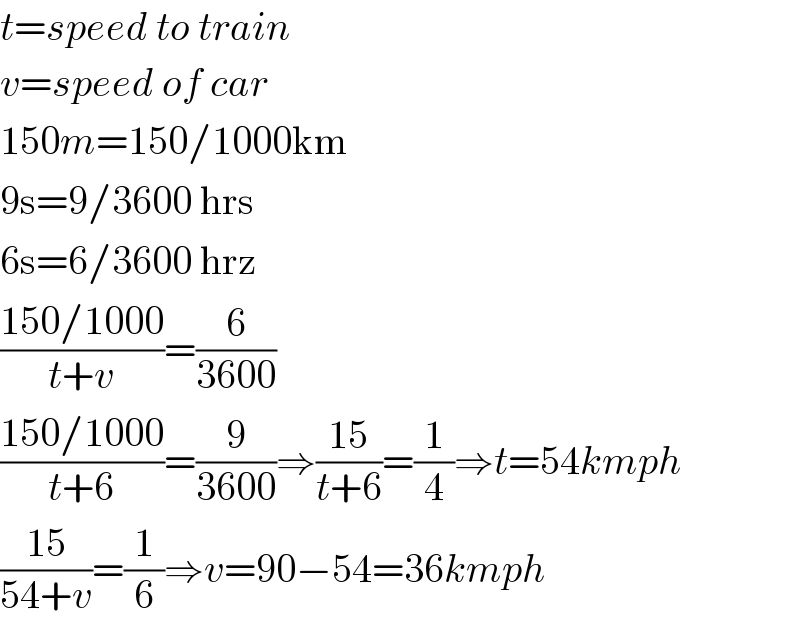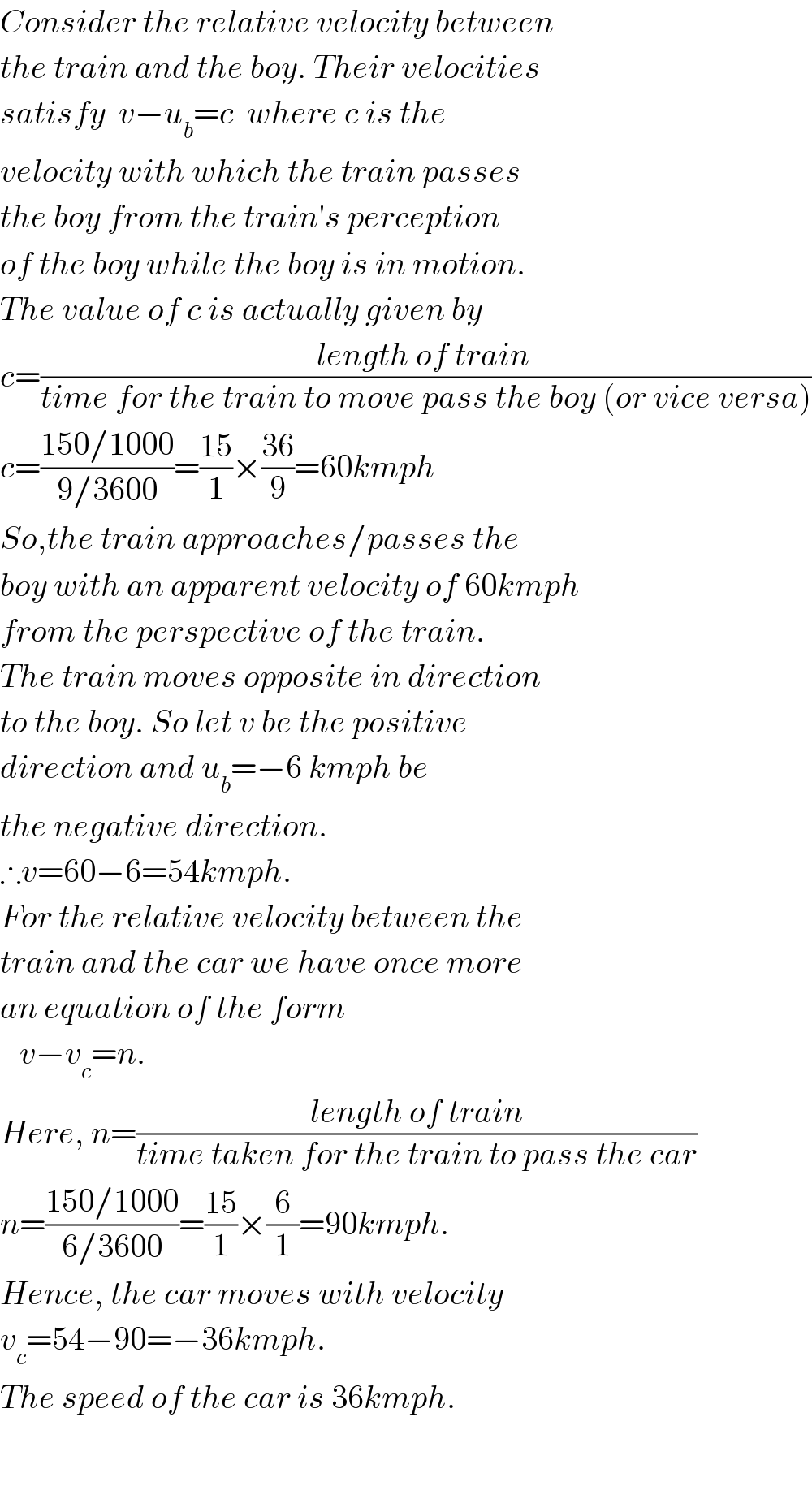
Question Number 4891 by Rasheed Soomro last updated on 19/Mar/16

$$\mathrm{A}\:\mathrm{train}\:\mathrm{150}\:\mathrm{metres}\:\mathrm{long}\:\mathrm{completely} \\ $$$$\mathrm{passes}\:\mathrm{a}\:\mathrm{boy}\:\mathrm{walking}\:\mathrm{in}\:\mathrm{the}\:\mathrm{opposite} \\ $$$$\mathrm{direction}\:\mathrm{at}\:\mathrm{6}\:\mathrm{kmph}\:\mathrm{in}\:\mathrm{9}\:\mathrm{seconds}\:\mathrm{and} \\ $$$$\mathrm{a}\:\mathrm{car}\:\:\mathrm{travelling}\:\:\mathrm{in}\:\mathrm{the}\:\:\mathrm{opposite}\: \\ $$$$\mathrm{direction}\:\mathrm{in}\:\mathrm{6}\:\mathrm{sec}.\:\mathrm{Find}\:\mathrm{the}\:\mathrm{speed}\:\mathrm{of} \\ $$$$\mathrm{the}\:\mathrm{car}. \\ $$
Commented by prakash jain last updated on 19/Mar/16

$${t}={speed}\:{to}\:{train} \\ $$$${v}={speed}\:{of}\:{car} \\ $$$$\mathrm{150}{m}=\mathrm{150}/\mathrm{1000km} \\ $$$$\mathrm{9s}=\mathrm{9}/\mathrm{3600}\:\mathrm{hrs} \\ $$$$\mathrm{6s}=\mathrm{6}/\mathrm{3600}\:\mathrm{hrz} \\ $$$$\frac{\mathrm{150}/\mathrm{1000}}{{t}+{v}}=\frac{\mathrm{6}}{\mathrm{3600}} \\ $$$$\frac{\mathrm{150}/\mathrm{1000}}{{t}+\mathrm{6}}=\frac{\mathrm{9}}{\mathrm{3600}}\Rightarrow\frac{\mathrm{15}}{{t}+\mathrm{6}}=\frac{\mathrm{1}}{\mathrm{4}}\Rightarrow{t}=\mathrm{54}{kmph} \\ $$$$\frac{\mathrm{15}}{\mathrm{54}+{v}}=\frac{\mathrm{1}}{\mathrm{6}}\Rightarrow{v}=\mathrm{90}−\mathrm{54}=\mathrm{36}{kmph} \\ $$
Answered by Yozzii last updated on 19/Mar/16

$${Consider}\:{the}\:{relative}\:{velocity}\:{between} \\ $$$${the}\:{train}\:{and}\:{the}\:{boy}.\:{Their}\:{velocities} \\ $$$${satisfy}\:\:{v}−{u}_{{b}} ={c}\:\:{where}\:{c}\:{is}\:{the}\: \\ $$$${velocity}\:{with}\:{which}\:{the}\:{train}\:{passes} \\ $$$${the}\:{boy}\:{from}\:{the}\:{train}'{s}\:{perception} \\ $$$${of}\:{the}\:{boy}\:{while}\:{the}\:{boy}\:{is}\:{in}\:{motion}. \\ $$$${The}\:{value}\:{of}\:{c}\:{is}\:{actually}\:{given}\:{by} \\ $$$${c}=\frac{{length}\:{of}\:{train}\:}{{time}\:{for}\:{the}\:{train}\:{to}\:{move}\:{pass}\:{the}\:{boy}\:\left({or}\:{vice}\:{versa}\right)} \\ $$$${c}=\frac{\mathrm{150}/\mathrm{1000}}{\mathrm{9}/\mathrm{3600}}=\frac{\mathrm{15}}{\mathrm{1}}×\frac{\mathrm{36}}{\mathrm{9}}=\mathrm{60}{kmph} \\ $$$${So},{the}\:{train}\:{approaches}/{passes}\:{the} \\ $$$${boy}\:{with}\:{an}\:{apparent}\:{velocity}\:{of}\:\mathrm{60}{kmph} \\ $$$${from}\:{the}\:{perspective}\:{of}\:{the}\:{train}. \\ $$$${The}\:{train}\:{moves}\:{opposite}\:{in}\:{direction} \\ $$$${to}\:{the}\:{boy}.\:{So}\:{let}\:{v}\:{be}\:{the}\:{positive} \\ $$$${direction}\:{and}\:{u}_{{b}} =−\mathrm{6}\:{kmph}\:{be} \\ $$$${the}\:{negative}\:{direction}. \\ $$$$\therefore{v}=\mathrm{60}−\mathrm{6}=\mathrm{54}{kmph}. \\ $$$${For}\:{the}\:{relative}\:{velocity}\:{between}\:{the} \\ $$$${train}\:{and}\:{the}\:{car}\:{we}\:{have}\:{once}\:{more} \\ $$$${an}\:{equation}\:{of}\:{the}\:{form} \\ $$$$\:\:\:{v}−{v}_{{c}} ={n}. \\ $$$${Here},\:{n}=\frac{{length}\:{of}\:{train}}{{time}\:{taken}\:{for}\:{the}\:{train}\:{to}\:{pass}\:{the}\:{car}} \\ $$$${n}=\frac{\mathrm{150}/\mathrm{1000}}{\mathrm{6}/\mathrm{3600}}=\frac{\mathrm{15}}{\mathrm{1}}×\frac{\mathrm{6}}{\mathrm{1}}=\mathrm{90}{kmph}. \\ $$$${Hence},\:{the}\:{car}\:{moves}\:{with}\:{velocity} \\ $$$${v}_{{c}} =\mathrm{54}−\mathrm{90}=−\mathrm{36}{kmph}. \\ $$$${The}\:{speed}\:{of}\:{the}\:{car}\:{is}\:\mathrm{36}{kmph}. \\ $$$$ \\ $$$$ \\ $$
